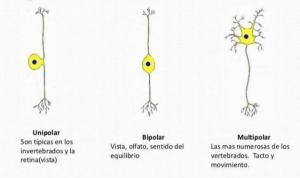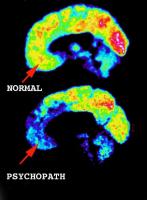Ventricular system of the brain: parts, characteristics and functions
The nervous system directs all the operations of our body. This is made up of various structures and other systems that interact with each other, allowing it to function properly.
Among these systems we find the ventricular, which, although simple at first glance, fulfills a series of fundamental functions that directly influence the health of our brain.
Throughout this article we are going to delve into what the ventricular system is, commenting on its development throughout the formation of the nervous system, its functions and, also, some diseases that it can present.
- Related article: "Parts of the human brain (and functions)"
What is the ventricular system?
In the brain we find gaps, cavities called ventricles, the set of which is called the ventricular system. It is a system that could well be compared to pipes, a system made up of several structures in the form of cavities that are connected to each other.
Despite the fact that the ventricles are empty and simple in appearance, these cavities actually fulfill fundamental functions for the nervous system, being the origin of the cerebrospinal fluid (CSF), a transparent liquid that bathes the brain and spinal cord spinal.
Formation of the ventricular system
The ventricular system develops at the same time as the rest of the central nervous system, facilitating the circulation of CSF throughout the process. One of the first milestones in the development of this system occurs on day 26 of embryonic development (4th week), which is when the differentiation of the optic ventricle begins. Later an evagination begins to take place in the medial line of the midbrain which, later, will constitute the cerebral or Silvio aqueduct.
Around the 6th week, the development of the interventricular foramen begins, starting the formation of the choroid plexuses of the lateral ventricles. From that moment on, the grooves and segmentation become somewhat more noticeable to the naked eye. After a few more weeks, the medial and lateral ventricular eminence increase in size, causing the spherical shape of the more primitive lateral ventricle to become a C. The horns of the lateral ventricles begin to become more prominent, and a small sac forms in the diencephalic floor, which in the future will become the third ventricle.
During the 7th and 8th weeks the end of the formation process of the ventricular system is reached. It is at this time that the horns end up defining themselves, the shape of the ventricles being almost definitely constituted. The isthymic part is compressed by the cerebellum, which is still growing, and many villi are spread in the midline.
Components of this system
The ventricular system is made up of four ventricles, which are connected to each other through various openings and channels. Next we will see in depth what its parts are:
1. Lateral ventricles (I and II V)
The lateral ventricles are the first and second ventricles, being the most voluminous cavities. They are located deep in both cerebral hemispheres and have an anterior horn that is oriented towards the frontal lobe, and a posterior horn that faces the temporal lobe. These two ventricles are connected through the third ventricle through the interventricular foramen of Monro. Both are C-shaped and their volume increases as the years go by.
Inside each one we find the choroid plexuses. The walls and roof of both ventricles are made up of neural structures, which constitute the frontal, parietal, temporal and occipital lobes, as well as nuclei of the base and the corpus callosum. We can identify in them the frontal horn (frontal lobe), the ventricular body (frontal and parietal lobes), occipital horn (occipital lobe) and the temporal horn (temporal lobe).
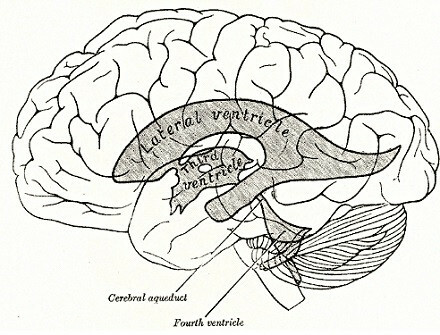
2. Third ventricle (III V)
The third ventricle is a flat and thin cavity, shaped similar to that of a bird's head.. It is a single chamber, smaller than the lateral and centrally located ventricles. As we have mentioned, it connects to the lateral ventricles through the orifices of Monro and to the rest of the ventricular system through the aqueduct of Silvio.
Inside we also find the choroid plexuses, specifically on its ceiling. The walls of this ventricle are formed by structures of the diencephalon, nuclei of the thalamus and the hypothalamus. At its rear end is the pineal gland, responsible for the production of melatonin, a hormone that regulates sleep and wake cycles.
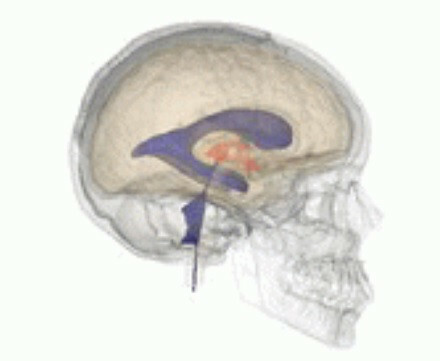
3. Fourth ventricle (IV V)
The fourth ventricle is occupying a space that runs from the midbrain aqueduct to the central canal of the upper part of the spinal cord.
Its floor, that is, the surface that constitutes the base of this cavity, is formed by the rhomboid fossa and communicates with the central canal through the Luschka and Magendie foramina, parts of which the CSF exits into space subarachnoid. This cavity connects with the subarachnoid cisterns, which allow CSF to reach the subarachnoid space.
If we travel inside the ventricles and reach the spinal cord, we will observe that the ventricles continue through the ependymal canal. This channel is a cavity that arises at the end of the fourth ventricle and runs through the medulla inside until it ends in the first vertebra of the lumbar area.
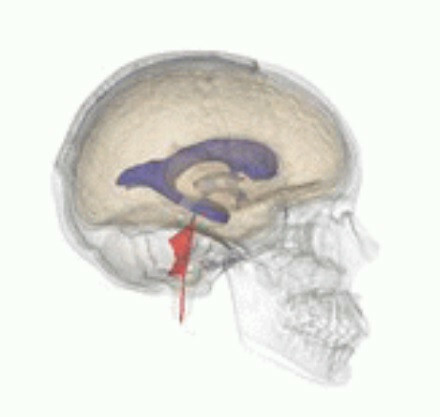
- You may be interested in: "Cerebrospinal Fluid: Composition, Functions, and Disorders"
Functions of the cerebral ventricular system
Although it may seem a very simple system for the simple fact of being composed of cavities, it It is true that the cerebral ventricular system performs several and very important tasks that are the following.
1. CSF production
As we have mentioned before, the main function of the cerebral ventricles is to produce cerebrospinal fluid. Likewise, it should be said that the ventricular system is not the only set of structures that make up this fluid, as per example the subarachnoid space, it should be noted that the ventricles are very involved in the manufacture of this liquid. This substance lubricates neural structures.
About 80% of CSF is synthesized in the choroid plexuses, and is the product resulting from the filtering of the blood that passes through them. The total volume of this fluid in an adult individual is about 150 ml. It is constantly produced and absorbed at a rate of 0.3 ml per minute, so its total volume is completely renewed about 3 times each day.
2. Brain buoyancy
CSF makes the brain float. This may seem unimportant at first, but it causes the relative weight of the brain to decrease dramatically, from about 1,400 grams to about 50 grams. This means that our head "does not weigh us down" so much.
3. Brain preservation
By producing CSF, the ventricles help maintain internal brain homeostasis, maintaining constant and adequate intracranial pressure. Added to this, the ventricular system helps eliminate waste, preventing infections and fatal damage to our brain.
It is very important to understand that the brain is an organ that is very sensitive to any chemical and physical change within the skull, thus a system altered ventricular cell in which not enough CSF is produced (or too much is produced) can lead to cognitive damage, although in a hint.
4. Immunoprotection and physical protection
As the last major function of the ventricular system, directly associated with its production of CSF, we have the fact that this fluid protects us against external agents, which could pose an infectious risk to our brain.
Added to this, the CSF constitutes an effective shock absorber, making the brain trauma soften in the event of an accident. although it should be noted that it is not 100% effective and there is always the risk of a cortical injury, especially if the impact has been very strong.
Ventricular system diseases
The ventricular system can suffer from various alterations and diseases, which condition not only the health of our brain but can also bring problems for the whole organism:
1. Hydrocephalus
Hydrocephalus is caused by excessive CSF production. As this disorder increases, intracranial pressure increases, which can lead to brain damage such as atrophy, metabolic and cognitive disorders. In the worst cases, hydrocephalus can lead to the death of the individual.
2. Ventriculitis
Ventriculitis is inflammation of the brain ventricles, which causes intracranial pressure to rise and also alters CSF circulation. This medical condition can be accompanied by hydrocephalus, encephalitis, and inflammation of the brain.
3. Meningitis
Meningitis is inflammation of the meninges due to an infectious agent, usually fungi, viruses and bacteria. This inflammation causes an increase in intracranial pressure, making it difficult for CSF to circulate and giving rise to different symptoms, mainly headaches, nausea, fever, sensitivity to light and in the worst cases cognitive impairment and even death.
- You may be interested in: "Meningitis: Causes, Symptoms, Treatment, and Prognosis"
4. Alzheimer disease
In Alzheimer's disease, un cognitive impairment caused by the death of neurons, a phenomenon that increases as the disease progresses. This causes a reduction in neuronal density, which causes the ventricles to turn each larger and larger because they occupy the space that remains as a result of the loss of volume cerebral.
5. Schizophrenia
In recent years, the possible relationship between schizophrenia and alteration of the ventricular system has been increasingly investigated. It is believed that people suffering from this psychiatric disorder could tend to present a greater dimension in the cerebral ventricles, having a greater ventricular dilation and a cortical decrease significant.

